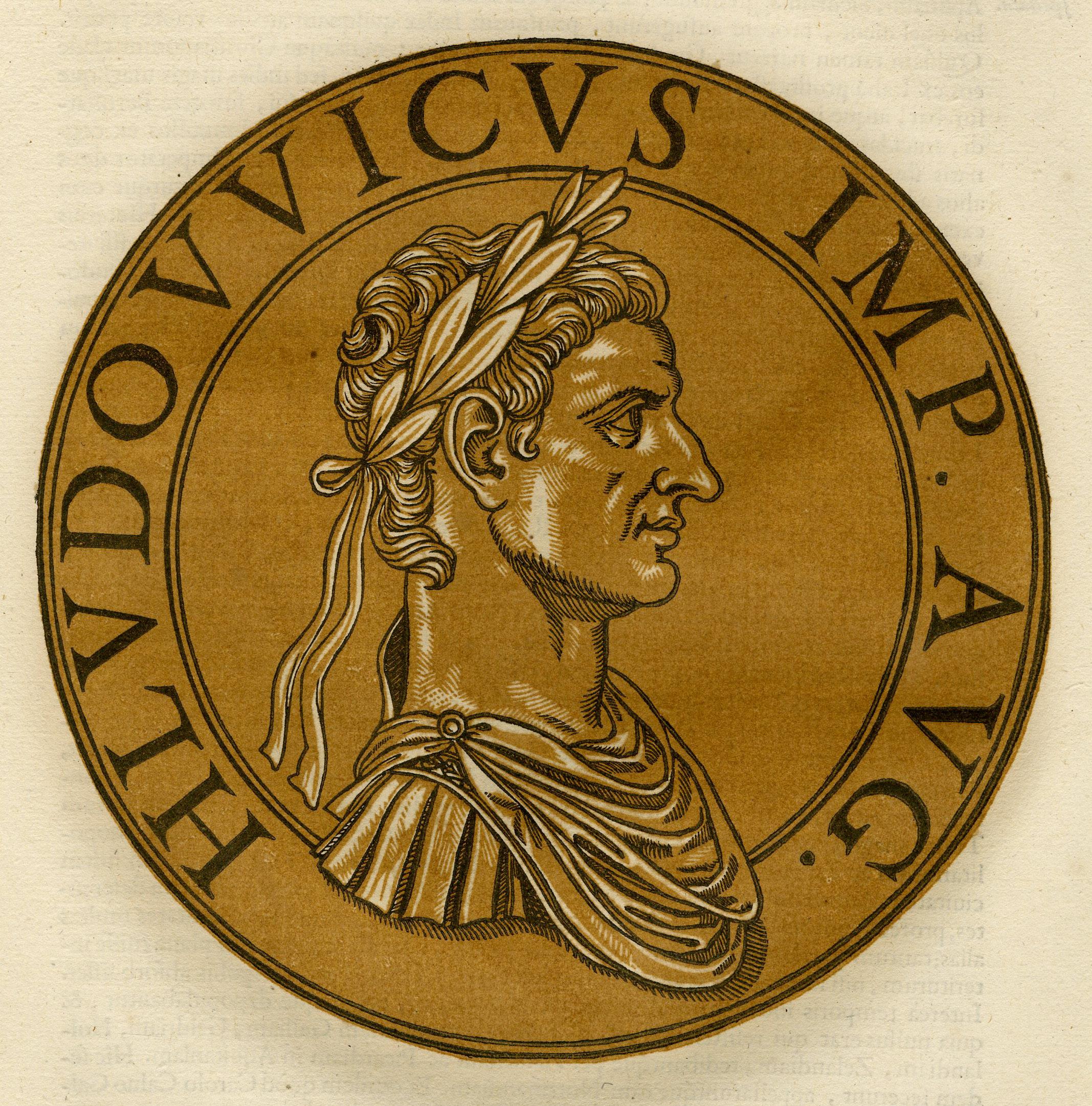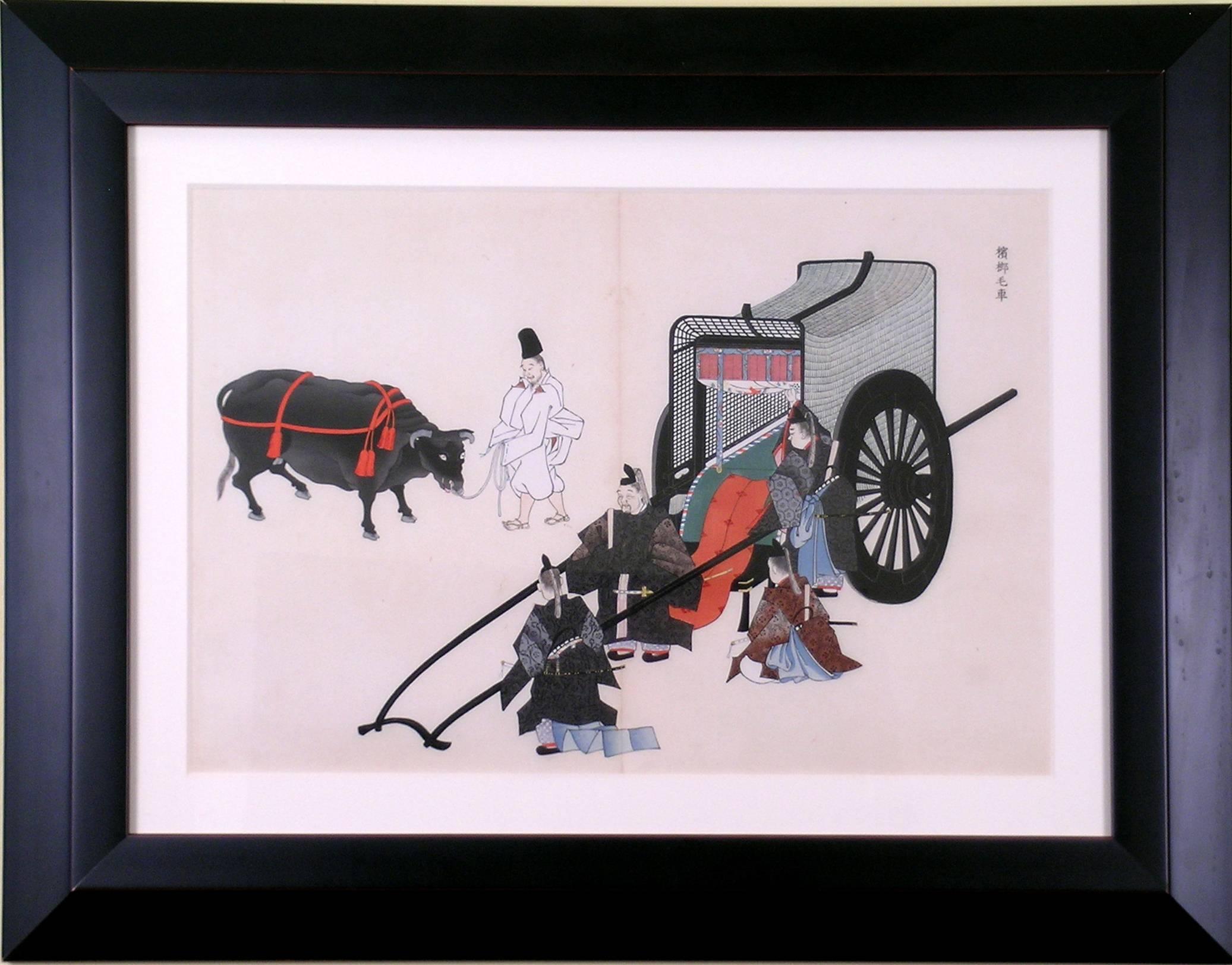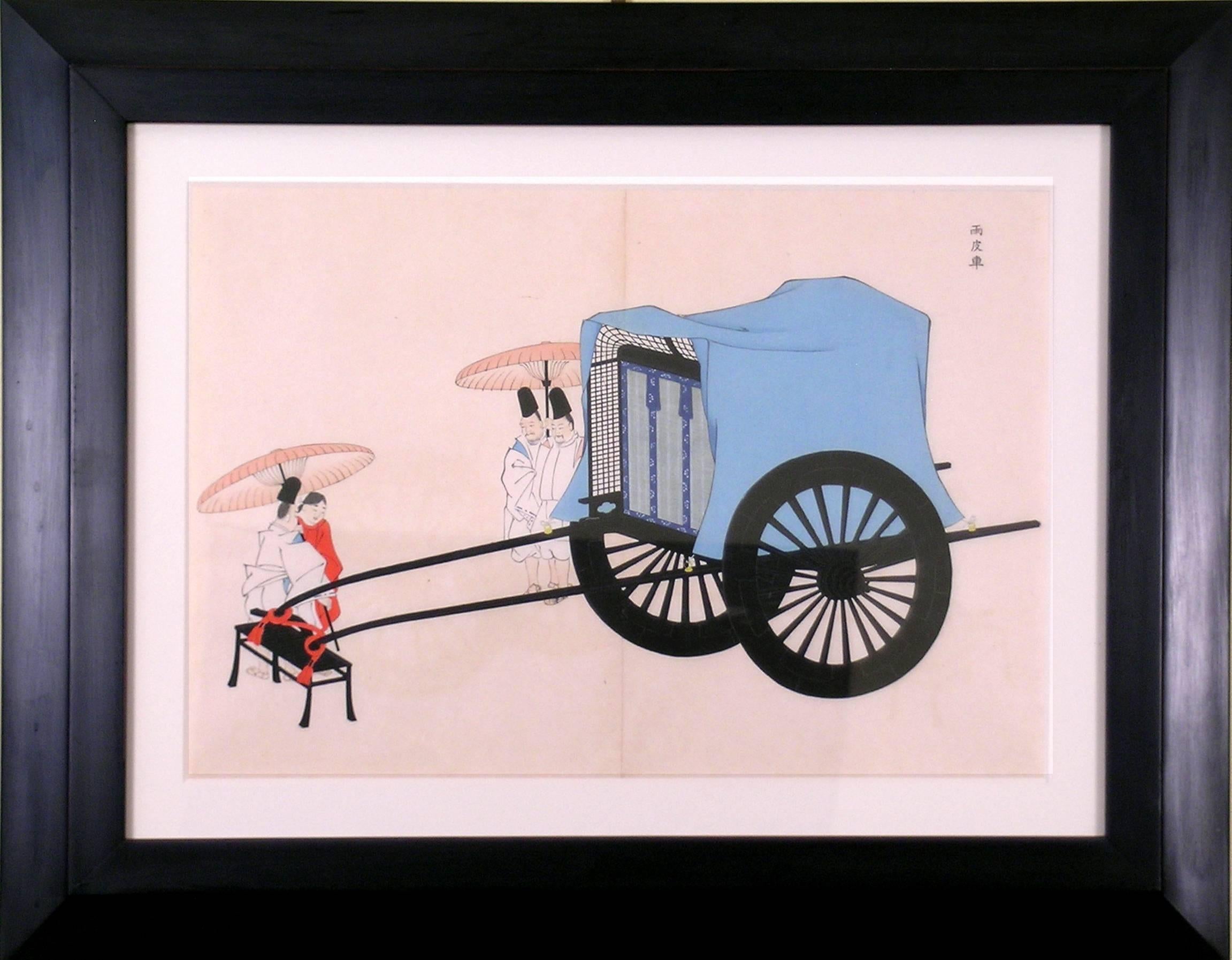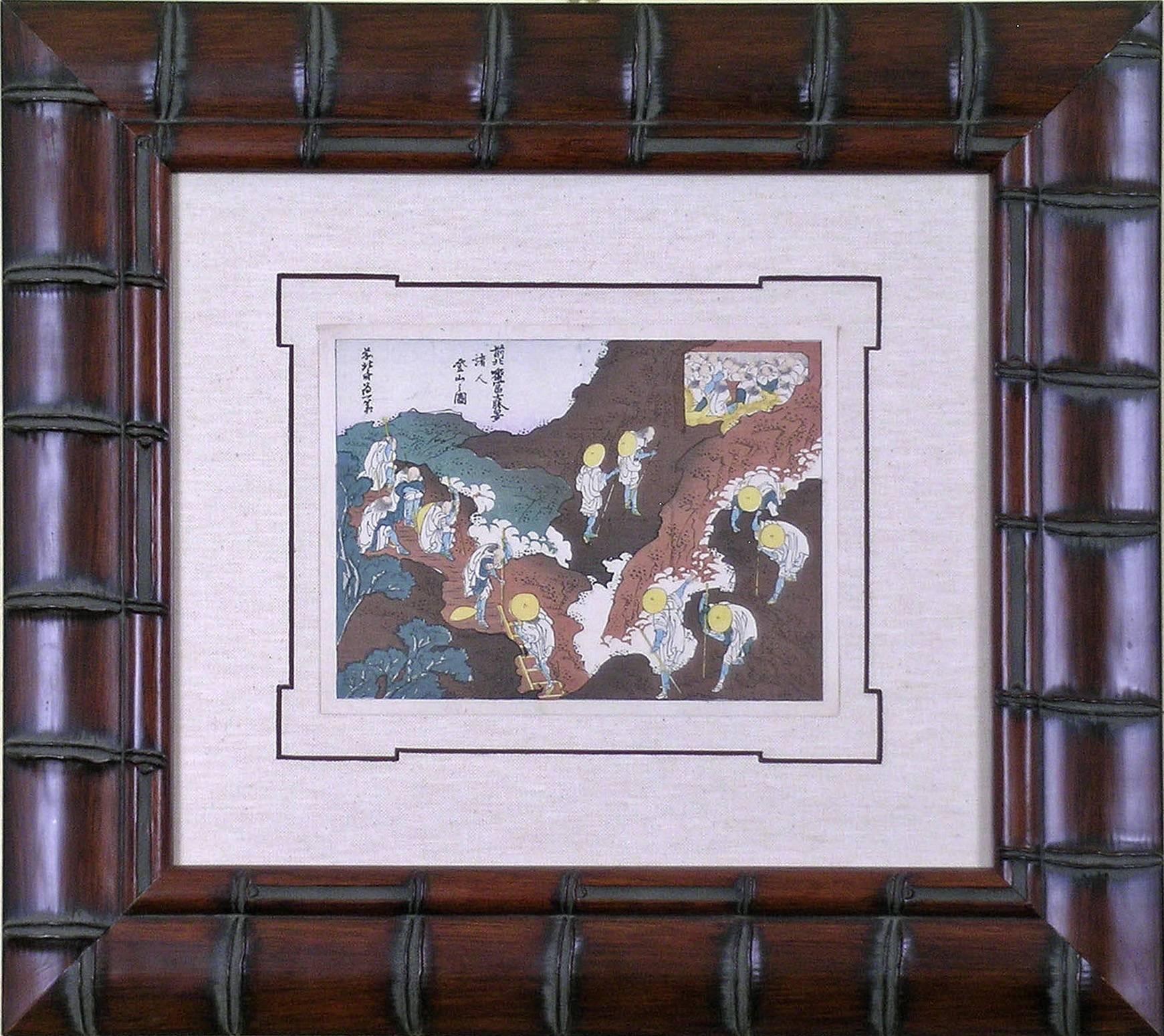Items Similar to Transport: Oxcart with 7 Men
Want more images or videos?
Request additional images or videos from the seller
1 of 5
Yosha Zuko FuzuTransport: Oxcart with 7 Menca 1900
ca 1900
About the Item
Yosha Zuko Fuzu
Meiji 33 (1900)
Writer: Kosugi Onson, Imaizumi Teisuke
Publisher: Yoshikawa Hanshichi
The Japanese litters and palanquins are much more than a practical vehicles for transport. They can also be a symbol of wealth and power. Every detail has a special significance. The quality, quantity, color and design of the hand-made embroidered silk fabrics add to the status of the passenger. The number of oxen needed and the hand-painted design of the palanquin and length of the yokes determine social class. Of course, there are man-powered litters as well. In each illustration we see the robe, sashes and hats worn by the carriers all adding to the worth of the patron. Of special significance is the color saffron denoting great extravagance. Each example holds a fascination in the meticulous attention to the smallest addition of a piece of trim and in the way a single knot is tied.
This work illustrates finely made and ornamented covered litters and palanquins to be carried by as many 15 men or several oxen. Every detail and movement is directed by additional staff. Only a very important individual could afford such extravagance.
Woodblock printing flowered in the Edo Period, mid to late 19th century, and is still considered an art form of great precision and beauty. The illustrations of these carts capture both the vitality and life inherent in the images of man, beast and carriage in each color woodblock print. Following the artist sketch, an image is carved into a block of wood. Black inks form the outline of the subject and color inks are applied to specific areas. The woodblock is then pressed to hand-made screened paper which is then hung dry. The entire process of composing a single image can take weeks.
- Creator:Yosha Zuko Fuzu (Japanese)
- Creation Year:ca 1900
- Dimensions:Height: 21 in (53.34 cm)Width: 27 in (68.58 cm)
- Medium:
- Movement & Style:
- Period:
- Condition:Clean, crisp image. Beautiful original color. Framed to museum specifications using archival matting, backing, hinging. Glazed with ultra-violet filtering Plexiglas.
- Gallery Location:Florham Park, NJ
- Reference Number:
About the Seller
5.0
Vetted Seller
These experienced sellers undergo a comprehensive evaluation by our team of in-house experts.
1stDibs seller since 2014
161 sales on 1stDibs
Typical response time: 2 hours
- ShippingRetrieving quote...Ships From: Florham Park, NJ
- Return PolicyA return for this item may be initiated within 1 day of delivery.
More From This SellerView All
- Oxcart with 5 Men and 1 OxBy Yosha Zuko FuzuLocated in Florham Park, NJYosha Zuko Fuzu Meiji 33 (1900) Woodblock with Original Hand-Coloring Writer: Kosugi Onson, Imaizumi Teisuke Publisher: Yoshikawa Hanshichi The Japanese litters and palanquins...Category
Early 1900s Academic Figurative Prints
MaterialsWatercolor, Woodcut
- The PlanLocated in Florham Park, NJSamurai Warriors Meiji 33 ( 1900) Woodblocks Original Hand-Color Woodblock printing flowered in the Edo Period in Japan, mid to late 19th century, and is still considered an ...Category
Early 1900s Academic Figurative Prints
MaterialsWatercolor, Woodcut
- Transport with 5 People and 2 ParasolsBy Yosha Zuko FuzuLocated in Florham Park, NJYosha Zuko Fuzu Meiji 33 (1900) Woodcut with Original Hand-Coloring Writer: Kosugi Onson, Imaizumi Teisuke Publisher: Yoshikawa Hanshichi The Japanese litters and palanquins a...Category
Early 1900s Academic Figurative Prints
MaterialsWoodcut
- Men on the MountainBy Katsushika HokusaiLocated in Florham Park, NJFUGAKU HYAKKEI Views of Mt. Fuji Katsushika Hokusai (1760-1849) Woodblock Print 1834-5 Edo period It signifies the long history and the aspirations of the race; it is a token ...Category
Mid-19th Century Academic Prints and Multiples
MaterialsWatercolor, Woodcut
- Dish GardenLocated in Florham Park, NJDish Garden in Blue and White China Japanese Woodblock Original Hand-color. Meji Period. Circa 1895. The enthusiasm for nature prints has spanned the centuries. By the mid-nineteenth century these works, illustrating varieties of flowers in naturalistic styles, had reached a peak of perfection. Each artistic form in traditional printing sought to enhance the beauty of botany. In the woodblock style, as it true for engravings and lithographs, it is imperative that the carving of each block be exacting as they must create an image true to that seen in nature. For many, the dish garden is a re-creation of a favorite landscape design. It provides an opportunity to build a perfect pairing of ornament...Category
Late 19th Century Academic Still-life Prints
MaterialsWatercolor, Woodcut
- Oxcart with 3 MenBy Yosha Zuko FuzuLocated in Florham Park, NJYosha Zuko Fuzu Meiji 33 (1900) Woodblock with Original Hand-Coloring Writer: Kosugi Onson, Imaizumi Teisuke Publisher: Yoshikawa Hanshichi The Japanese litters and palanquins...Category
Early 1900s Academic Figurative Prints
MaterialsWatercolor, Woodcut
You May Also Like
- Louis I of France as a Roman Emperor, in profile to the rightBy Christoffel JegherLocated in Fairlawn, OHLouis I of France as a Roman Emperor, in profile to the right Chiaroscuro woodcut, 1631-1633 Unsigned (as usual) After a drawing by Hubert Goltzius (1526-1583)...Category
17th Century Academic Portrait Prints
MaterialsABS, Woodcut
- Greek Architecture Blueprint of Ancient Amphitheatre Cyanotype Print, WatercolorBy Kind of CyanLocated in Barcelona, ESThis is an exclusive handprinted limited edition cyanotype. Details: + Title: Ancient Roman Amphitheater + Year: 2022 + Edition Size: 50 + Stamped and Certificate of Authenticity provided + Measurements : 70x100 cm (28x 40 in.), a standard frame size + All cyanotype prints...Category
2010s Academic Still-life Photography
MaterialsPhotographic Film, Woodcut, Emulsion, Watercolor, C Print, Color, Lithog...
- Glengairn, Aberdeenshire - Signed Lithograph, Royal Art, Scotland, BritishLocated in Knowle Lane, CranleighGlengairn, Aberdeenshire, January by His Majesty King Charles III - Hand Signed Limited Edition Lithograph. Belgravia Gallery has been ...Category
Early 2000s Academic Landscape Prints
MaterialsLithograph
- Wensleydale - Signed Lithograph, Royal Art, Yorkshire, British Landscape, DalesLocated in Knowle Lane, CranleighWensleydale by His Majesty King Charles III - Hand Signed Limited Edition Lithograph. Belgravia Gallery has been honoured to be associat...Category
1990s Academic Landscape Prints
MaterialsLithograph
- Wensleydale from Moorcock - Signed Lithograph, Royal Art, Yorkshire, LandscapeLocated in Knowle Lane, CranleighWensleydale from Moorcock by His Majesty King Charles III (created when he was HRH Prince Charles, The Prince of Wales) - Hand Signed Lim...Category
1990s Academic Landscape Prints
MaterialsLithograph
- InnamoratiBy Emilio GrecoLocated in Ljubljana, SIInnamorati (eng. Lovers). Original drypoint, 1982. Edition of 90 signed and numbered impressions on Arches paper. Emilio Greco is one of the greatest sculptors, engraver and medalist of modern time. He is best known for his monumental bronze sculptures of the human figure. The sculptures and figures in graphics, primarily female nudes and portraits, tended to be refined, with elongated forms in the Italian...Category
1980s Academic Figurative Prints
MaterialsDrypoint





